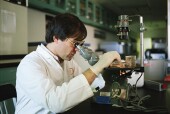
MONDAY, Feb. 8 (HealthDay News) — Scientists say they’ve developed a new and easier way to create what’s known as pluripotent stem cells — cells that can develop into one of many cell types for use in regenerative medicine.
Unlike many other methods, this new technique doesn’t use viruses to introduce genes into cells or permanently alter a cell’s genome. Instead, tiny circles of DNA are used to transform stem cells taken from human fat into induced pluripotent stem cells, which are the starting point for research into many human diseases.
This is the first time that adult (non-embryonic) stem cells have been reprogrammed this way and it could be an important advance toward the use of such cells in humans, according to the Stanford University School of Medicine researchers.
“This technique is not only safer, it’s relatively simple,” study co-author Dr. Michael Longaker, a professor of surgery and deputy director of Stanford’s Institute for Stem Cell Biology and Regenerative Medicine, said in a Stanford news release. “It will be a relatively straightforward process for labs around the world to begin using this technique. We are moving toward clinically applicable regenerative medicine.”
The researchers plan to create pluripotent stem cells to learn more about, and perhaps some day treat, human heart disease.
“Imagine doing a fat or skin biopsy from a member of a family with heart problems, reprogramming the cells to pluripotency and then making cardiac cells to study in a laboratory dish. This would be much easier and less invasive than taking cell samples from a patient’s heart,” study senior author Dr. Joseph Wu, an assistant professor of cardiology and radiology and a member of Stanford’s Cardiovascular Institute, said in the news release.
The study was published online Feb. 7 in the journal Nature Methods.
More information
The U.S. National Institutes of Health has more about stem cells.

